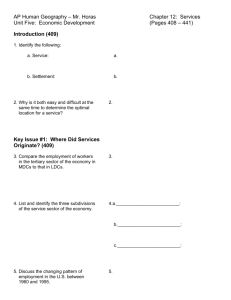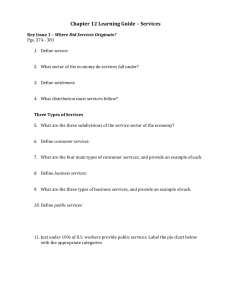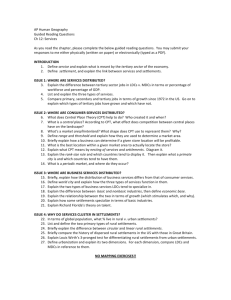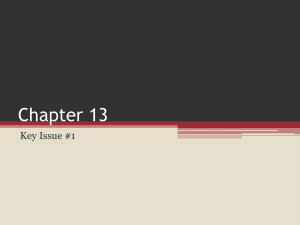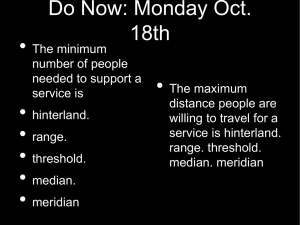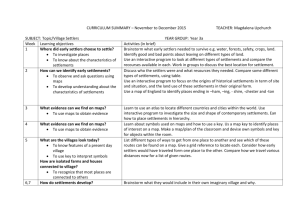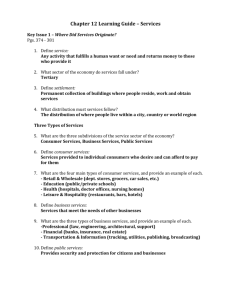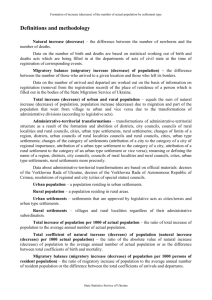Ch 12 Guided Reading
advertisement
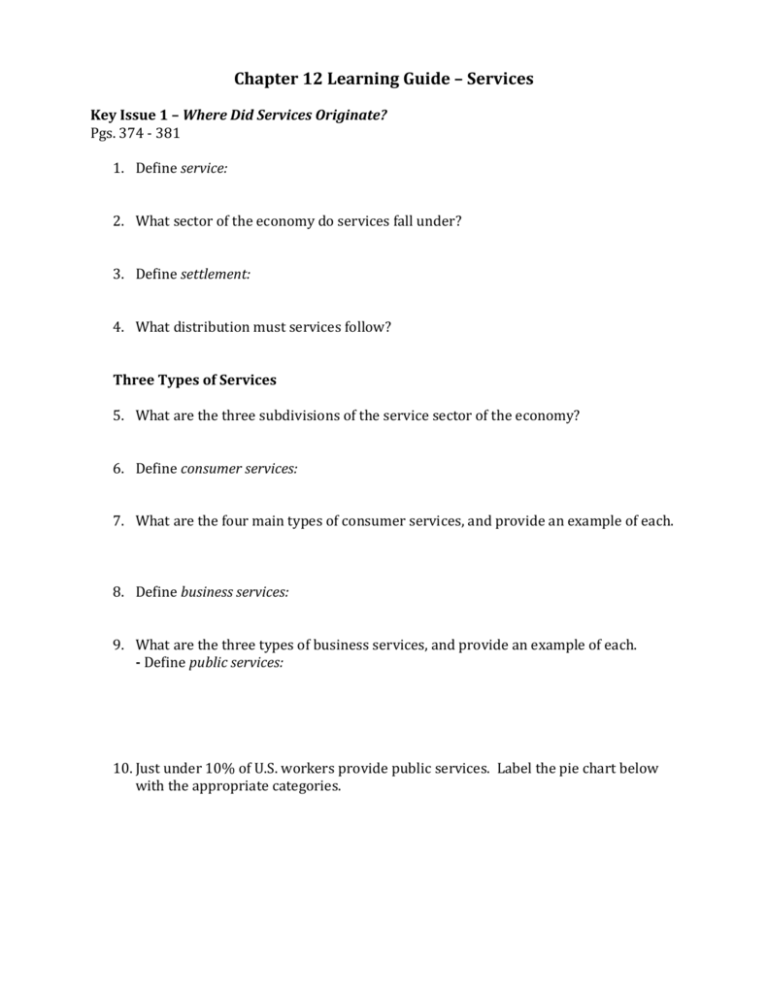
Chapter 12 Learning Guide – Services Key Issue 1 – Where Did Services Originate? Pgs. 374 - 381 1. Define service: 2. What sector of the economy do services fall under? 3. Define settlement: 4. What distribution must services follow? Three Types of Services 5. What are the three subdivisions of the service sector of the economy? 6. Define consumer services: 7. What are the four main types of consumer services, and provide an example of each. 8. Define business services: 9. What are the three types of business services, and provide an example of each. - Define public services: 10. Just under 10% of U.S. workers provide public services. Label the pie chart below with the appropriate categories. U.S. Government Workers 25% Federal 50% Local Gov't 25% State A B C 11. Explain where an increase and/or decrease have occurred in each of the following categories. (Use the reading and Fig. 12-2 as a guide) Changes in Number of Employees between 1972 and 2009 Business Services - Increase in professional services - Decrease in finance & transportation due to improved efficiency where fewer workers are needed Consumer Services - Increase in healthcare, education & entertainment Retail has decreased Services in Early Rural Settlements 12. Based on archaeological research, what services were most likely provided in history’s earliest settlements? Consumer and public services 13. What early structures and permanent man-made features were associated with the first settlements? Places for ceremonies of the dead such as temples Places for dwellings such as houses 14. What early structures and permanent man-made features were associated with early public services? Walls and citadels for defense 15. What early structures and permanent man-made features were associated with early business services? Services in Early Urban Settlements 16. Identify four potential “hearth regions” for the world’s first urban settlements. 17. List three characteristics of the world’s first cities that emerged around 2000 BCE, as deduced from the excavations of Ur (modern Iraq) and Titris Hoyuk (modern Turkey). 18. What was a city-state? 19. What services did the city-state provide to the surrounding hinterland? 20. Large cities, such as ancient Athens, began to supply what types of things not available in smaller settlements? 21. Why did these large centers collapse with the fall of the Roman Empire in the 5th century CE? 22. What role did trade play in the revival of urbanism during the Middle Ages? 23. What were the five largest cities in the world during the Middle Ages (around 900)? Chapter 12 Learning Guide – Services Key Issue 2 – Where Are Contemporary Services Located? Pgs. 381 – 387 Services in Rural Settlements 1. Define clustered rural settlement: 2. Define dispersed rural settlement: 3. How are strips of land allocated in a clustered rural settlement? 4. Illustrate a circular rural settlement. 5. In a linear rural settlement, why are settlements clustered around roads and/or rivers? 6. Why did New England colonists prefer clustered settlements? 7. Why had owning several fields around a clustered rural settlement become disadvantageous? 8. Why did many European countries convert to dispersed patterns? 9. Define enclosure movement: 10. What happened to England’s displaced farmers? 11. Complete the chart with several bullet notes detailing the characteristics of urban settlements according to Louis Wirth. Large Size High Density Social Heterogeneity 12. Explain the difference between number or people living in large cities and the percentage of people living in large cities as it relates to MDCs and LDCs. Chapter 12 Learning Guide – Services Key Issue 3 – Why Are Consumer Services Distributed in a Regular Pattern? Pgs. 387 – 394 Central Place Theory 1. Define central place theory: 2. What does central place theory seek to explain? 3. Define central place: 4. What is a market area? 5. What other term is sometimes used to refer to a market area? 6. What shape does central place their hypothesize for market areas? 7. Why this particular shape? 8. Complete the pyramid below regarding the concept of range. RANGE Definition: Services with LONG ranges: Services with SHORTER ranges: 9. Complete the pyramid below regarding the concept of threshold. THRESHOLD Definition: Not all people within a market area can be counted when determining location of a service by considering its threshold. Explain how this is so, and provide examples Market Area Analysis 10. According to geographers, where is the best location for a service (once range and threshold have justified its viability)? 11. The gravity model helps explain this as the optimal location is _________________ related to the number of people in the area an _______________ related to the distance they must travel. 12. What two patterns are reflected by consumer behavior? Hierarchy of Services and Settlement 13. Small settlements have services with ______________ thresholds, __________________ ranges and __________________ market areas. 14. Larger settlements have __________________ thresholds, ranges and market areas. 15. However, smaller neighborhoods within larger settlements must also do what? 16. Who created the original study in central place theory? Where? 17. Who documented the central place phenomenon in the U.S.? Where? 18. In MDCs, the pattern of cities follows the rank-size-rule. What is it? 19. If the largest city in a country is more than twice the size of the second city, it is said to be what? 20. What is the situation in Europe and LDCs with regard to “rank-size” distribution and primate cities? EUROPE LDCs 21. Define periodic market: 22. What groups of people and areas are provided goods by periodic markets? Chapter 12 Learning Guide – Services Key Issue 4 – Why Do Business Services Cluster in Large Settlements? Pgs. 394 – 400 Hierarchy of Business Services 1. Read this section and answer the questions in the chart below. WORLD CITIES List the 3 largest world cities: COMMAND & CONTROL CENTERS What do they share What is the “second tier” of world cities called? What services do these cities contain? Give several example cities from U.S. SPECIALIZED PRODUCER SERVICES CENTERS Give examples of specializations & cities represented by each. DEPENDENT CENTERS List the four sub-types of dependent centers and where they are located. Business Services in LDCs 2. What functions do offshore centers provide, and explain each? 3. Where is a prominent example of an offshore center? 4. What are typical back-office functions? 5. Why have LDCs been able to attract back offices? Economic Base of Settlements 6. Define industry: 7. Define non-basic industry: 8. What is the economic base of a community? 9. Explain how a basic industry creates new types of jobs. 10. Basic industries originally referred to ___________________________, but in a postindustrial society, increasingly, the basic industries are in _________________, __________________, and _____ _______ services. 11. Complete the graphic below to illustrate the question above with regard to the cities of Cleveland and Baltimore. Cleveland’s economic base during the industrial period… Cleveland’s economic base in post-industrial society is… Baltimore’s economic base during the industrial period… Baltimore’s economic base in post-industrial society is… 12. What did Richard Florida’s research deduce?
